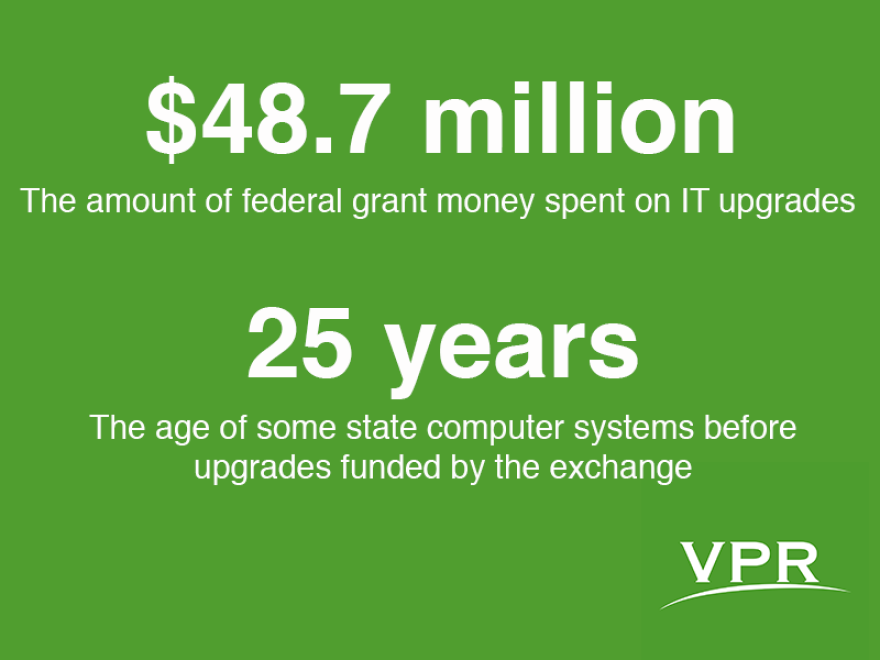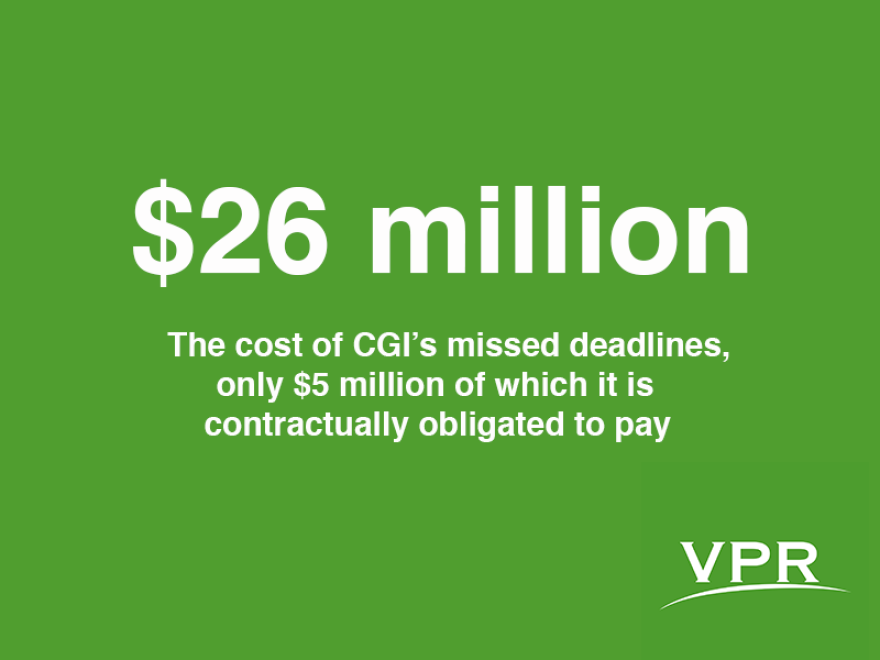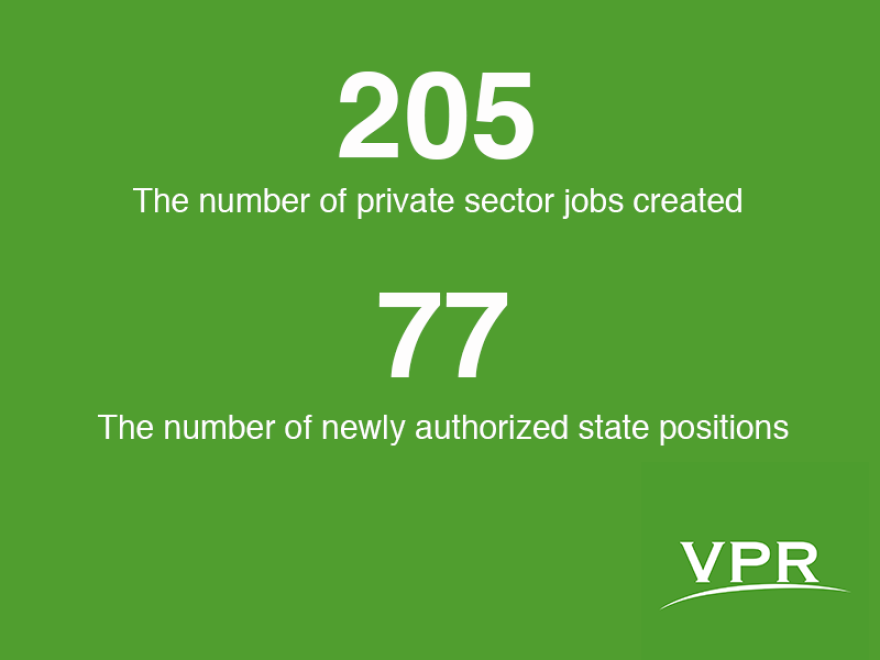An unprecedented amount of federal money has flowed into Vermont to design the state’s health insurance marketplace.
The money was authorized under the 2010 Affordable Care Act. And Vermont got more money per capita to build and launch its health exchange than any other state.
This project is the most expensive and complicated information technology build out that the state has ever undertaken. Here’s where the money came from, and how it was spent:
In the past two and a half years, Vermont has received roughly $172 million in four separate federal grants to design its own exchange, upgrade state computer systems, and launch a massive outreach campaign to educate Vermonters about how their insurance options would change in January of 2014.
Sights on single payer
It’s clear from the grant documents that Vermont officials consider the new private insurance exchange to be a stepping stone to a publicly financed, single payer system. Gov. Peter Shumlin’s goal is to implement this system in 2017.
The budget narrative for the first federal grant described the state’s approach this way: “The State of Vermont aspires to create for its residents a health care system in which all residents receive coverage from a single source. Because of this ambitious undertaking, Vermont has come to see the role of a Health Benefits Exchange somewhat differently than do most states.”
This project is the most expensive and complicated information technology build out that the state has ever undertaken.
Of the 16 states that chose to set up their own exchange, Vermont is the only state in the country that decided to make participation mandatory for individuals and small businesses – employers with fewer than 50 employees. This means these groups have to go through the exchange if they want to have coverage after Jan. 1.
Shumlin has said the mandatory approach is a way to lead the way to single payer and also allow individuals to take full advantage of federal subsidies for coverage in 2014.
“I think that we’ll find other states will join Vermont going forward in having made that decision,” he said last month. “I recognized right from the beginning that one of the challenges seemed to me, to the Affordable Care Act, is to spend all this money and then not many people show up.”
Leveraging the grant dollars
Mark Larson, the commissioner of the Department of Vermont Health Access, said it was very important to design an exchange that could also be used for a single payer system. But he said adding this dimension did not add any additional costs to the project.
“We understand the important investment that we’re making in our exchange and our IT projects and we need to make sure that we’re maximizing the use and reusability of that technology,” he said.

Larson said it would have been very difficult to implement all of the complex software programs needed for the exchange because the state had antiquated computer systems for its human services benefit programs. He said some elements of the system were more than 25 years old. So the state is using almost $50 million of the federal grant money to totally upgrade its computer systems:
“We’ve definitely taken advantage of the federal funding for exchanges to help rebuild the technology that our Human Service Agency relies on that had to be replaced anyway,” he said.
"We've definitely taken advantage of the federal funding for exchanges to help rebuild the technology that our Human Service Agency relies on that had to be replaced anyway." - Mark Larson
The contractors
Almost two thirds of the $172 million grant total is being paid to a group of private contractors and consulting firms.
For instance, Wakely Consulting of Boston has a contract for just over $6 million to “assist with planning, designing, and developing of Vermont’s exchange.”
The Washington D.C. based public relations and political consulting firm GMMB got almost $3 million to design a public outreach and education plan. The contract also included a program to train hundreds of navigators throughout the state to help individuals and businesses better understand their insurance options.
Maximus Inc., a technology firm based in Reston Virginia, has a $4.5 million contract to provide information technology consulting services to the state. HMC2 Advertising is overseeing a $2 million TV, radio and print campaign to promote the exchange.
In all of these cases, the final amount increased dramatically from the original contract through a series of amendments. For example, the Wakely contract expanded from $2 million to $6 million award. The original $400,000 Maximus contract grew to be a $4.5 million dollar deal.

Commissioner Larson argues these amended contacts shouldn’t be viewed as cost overruns.
“In every case where there’s been an increase in the cost of a contract that is because we have asked for more services or products from that vendor not that what we originally asked for in the contract got more expensive,” he said.
About $10 million in federal grant money is also being used to pay for the call center at Vermont Health Connect where more than 175 people are employed answering specific questions about coverage through the exchange.
And then there’s the massive contract awarded to the Canadian IT firm, CGI Technologies and Solutions, to oversee the building of the exchange and to provide “systems integration and technology infrastructure” for the entire exchange.
The original CGI contract was for $42 million over a multi-year period. Through a series of amendments, this contract doubled to $84 million dollars.
The original CGI contract was for $42 million over a multi-year period. Through a series of amendments, this contract doubled to $84 million dollars.
Throughout 2013, CGI missed a number of key deadlines for the operation of the exchange. Commissioner Larson said these problems were a big reason factor why the exchange wasn’t fully functional by the target date of Oct 1:
“We were working on a very, very tight schedule to complete a very complex project with the expectation in statute that it would be delivered on a date certain,” he said.
Penalties ahead?
The state estimates that CGI’s missed deadlines have cost $26 million. But under the terms of its contract, CGI’s potential monetary penalties are capped at $5 million. The governor said he intends to fight to get the maximum penalty.

“This governor is miserable at the place where we are with this website and I’m not being funny,” Shumlin said. “The folks that we’re working with, the vendors that we’ve engaged, have not delivered on the product that we were promised. That makes me miserable I’m going to make sure it makes them miserable until we get it right.”
"The folks that we're working with, the vendors that we've engaged, have not delivered on the product that we were promised. That makes me miserable I'm going to make sure it makes them miserable until we get it right.” - Gov. Peter Shumlin
Because the online payment system didn’t work, Shumlin offered small businesses several options. They could purchase their coverage directly from the insurance companies, Blue Cross and MVP, or they could extend their current coverage for the first three months of next year. The vast majority of small businesses have chosen the direct purchasing approach.
The Shumlin Administration is being criticized for its handling of the exchange from the political right and left.
Internal reports obtained by VPR show the state was warned as early as last spring about missed deadlines, staffing shortages and other problems that threatened the Oct. 1 launch.
Burlington Progressive Chris Pearson is concerned that the Administration wasn’t forthright with key legislative committees about the issues developing with the exchange during the summer and early fall.
“Since it wasn’t going to work on day one, and they had to know that ahead of time, I think they should have come clean and said ‘we’re going live, here are some of the challenges please bear with us,’” he said. “At the end of the day we need health care to be affordable and accessible to all Vermonters, and this is not going to satisfy that.”
Republican Lt. Gov Phil Scott, who serves in Gov. Shumlin’s cabinet, wants to delay the mandatory implementation of the exchange for a year because of the problems with the online payment system.

“This is a huge endeavor. This is the biggest thing that we’ve faced as a state from a technological stand point ever. So maybe we should have planned a little bit better,” Scott said. “Maybe we should have given it a little more time… whatever it takes to make sure we get this right and give comfort to Vermonters.”
Shumlin has rejected this approach. He argues that delaying everything for a year causes more problems than it solves including the difficulty of determining new premium rates for the insurance companies.
"Maybe we should have planned a little bit better ... Maybe we should have given it a little more time." - Lt. Gov. Phil Scott
There is no timeframe for the online payment system to be operating but if it’s not in place by Feb. 1, the governor might have to consider a new set of options for small businesses:
“As you know I’ve lost confidence in the contractors that promised to have a perfectly humming website on Oct. 1, so we think we can do it; we think we’re going to do it, but I’ve stopped being surprised,” he said.
It’s likely that key legislative committees will want to conduct their own investigations into the problems that have plagued the state’s health care exchange.
And that oversight could evolve into a tough political issue for the administration if the online payment system isn’t working in the next few months because many of the small businesses that have extended their coverage will question what their next option is going to be.







